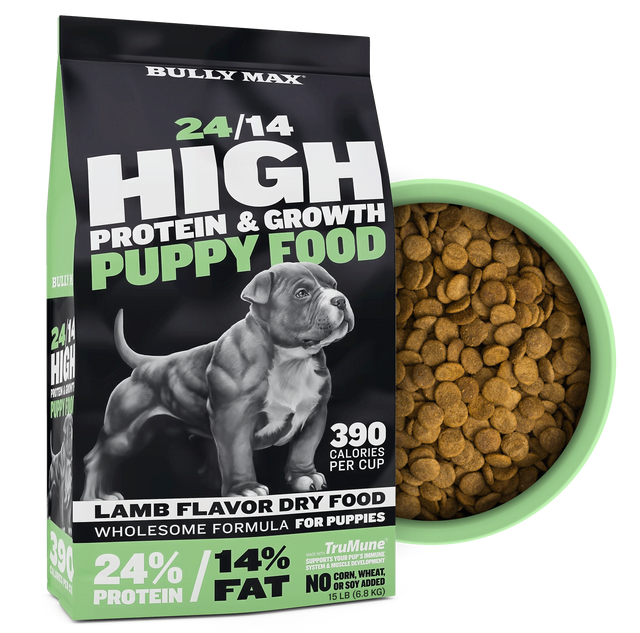How to Know When to Switch to Adult Dog Food
“How long should a puppy eat puppy food?” Maybe you’ve wondered this yourself, and rightly so. It can be a confusing topic, but it’s important to know when your puppy is ready to make the transition to adult dog food.

The important thing to realize is that because puppies are still growing, they need more calories and nutrition than adults. In fact, feeding an adult diet to a puppy could lead to nutritional deficiencies.
Likewise, feeding a puppy diet to an adult could cause excessive weight gain and its related issues. This is important to avoid, since obesity is the most common nutrition-related issue for canines. Knowing when to switch to adult dog food will help your puppy grow into a happy, healthy dog.
That being said, there’s no one-size-fits-all answer to this question. Instead, you’ll want to change from puppy food to dog food based on your dogs’ breed, size, and age. Read on to learn how and when to switch to adult dog food.
When to Stop Feeding Puppy Food
The right time to stop feeding puppy food is when your puppy has fully transitioned to adult dog food. The specific period of doing this transition depends on your puppy’s breed, size and age. For instance, smaller breeds tend to reach their adult size quicker than larger breeds implying that they can stop eating puppy food before they turn 1 year old. Additionally, ensuring that your puppy has fully transitioned to adult dog food first before stopping puppy food altogether prevents diet-related problems such as picky eating and food intolerance.
When to Switch to Adult Dog Food
You should switch to adult dog food when your puppy is within the age range of 9-24 months old. As you can see this is quite a big range, so this is just a general rule of thumb. The exact age at which a dog is ready for adult food actually depends on the size of the dog—most dogs should switch to adult food when they are 75-85% of their full adult size.

Toy, Teacup and Tiny Dog Breeds
Toy, teacup and tiny dog breeds include breeds such as Yorkshire Terrier, Maltese, Chihuahua, Shih Tzu, Pomeranian, Miniature Pinscher, etc. Fully grown, these cute little canines generally weigh 12 pounds or less. Most tiny dogs should reach their adult weight, such as it is, around 8-10 months old.
Small Dog Breeds
Small dog breeds include breeds such as Charles Spaniel, French Bulldog, Jack Russell Terrier, Pug, Border Terrier, and Miniature Schnauzer. Fully grown, they generally weigh between 12 and 25 pounds, and they will typically reach this adult weight at 8-12 months of age. Consider giving them specially formulated small breed dog food for skin, coat & digestive health.
Medium Dog Breeds
Medium dog breeds include breeds such as Border Collie, Bulldog, Cocker Spaniel, Corgi, English Springer Spaniel, Basset Hound, and Barbet. These dogs will reach a total of around 25 and 50 pounds at around 10-12 months of age.
Large Dog Breeds
Large dog breeds include breeds such as Golden Retriever, Bloodhound, Doberman Pinscher, German Shepherd Dog, Alaskan Malamute, Boxer, Pitbull, and Labrador Retriever. At 12-18 months of age, these dogs will reach their adult weight of 50 and 100 pounds.
Giant Dog Breeds
Giant dog breeds include breeds such as Bernese Mountain Dog, Bullmastiff, Newfoundland, Saint Bernard, Great Dane, Irish Wolfhound, Akita, etc. These dogs will typically reach their adult weight between 12 and 24 months. Fully grown their weight can easily exceed 100 pounds (which is why you shouldn’t let one of these dogs step on your toe!).
Why Should You Switch From Puppy Food to Adult Dog Food?
A puppy’s needs are not the same as an adult’s. Puppy foods have greater quantities of certain nutrients, including calories, because puppies require more macronutrients and minerals than an adult dog of the same size and weight.
This important stage of growth and development requires a lot of energy, after all!
This is why puppies are at risk for nutritional deficiencies and malnourishment if they are fed adult dog food. Adult dog foods have been designed to accommodate the decrease of energy levels and growth that comes with maturity. Rich puppy food can easily cause obesity and myriad other health problems for adult dogs, so it’s important to know when to switch to adult dog food.
Puppy Food vs Adult Dog Food
So what’s the difference between puppy food and dog food, anyways? For starters, puppies need more protein and fat than an adult dog of the same size. They also require higher concentrations of certain minerals, vitamins, and amino acids.
For this reason, puppy food is more calorie- and nutrient-dense. You will find essential nutrients such as calcium, phosphorus, sodium, and chloride all in greater concentrations in puppy food. Sometimes puppy foods are also supplemented with things such as extra omega-3 fatty acids. These can support healthy eye and brain development.
Keep in mind that larger breeds can be at a greater risk of developmental diseases as a result of overly rapid growth. This is why large breed puppy foods have a little less fat, calcium, and phosphorus. This ensures that they develop and grow at an appropriate and healthy pace.
What Happens If a Puppy Eats an Adult Dog Food
If your puppy just accidentally ate a few meals of adult dog food, it won't necessarily make him ill. Aside from possible bouts of gastrointestinal upset, your puppy should be fine because adult dog food is dog food after all. However, if your puppy eats adult dog food for a huge portion of his growing period, various problems may be observed. Some of these problems include stunted growth, weak muscles and joints, fragile bones, suppressed immune system and persistent infections. More serious problems such as heart disease and bone marrow dysfunctions may also be a result of malnutrition from not feeding the recommended diet for puppies.
How to Switch Your Dog’s Diet to Adult Dog Food
Think it’s time to make the switch from puppy food to adult dog food? Great! The key thing to keep in mind here is that it’s a process.
With that in mind, the best way to transition is slowly. Even if you’re transitioning to a well-balanced, high quality dog food, transitioning too fast can cause vomiting, diarrhea, and other issues related to digestion. This can even potentially lead to your dog refusing or disliking that particular type of dog food, because they associate it with feeling sick.
So ease into it. When it’s time to make the switch, start by feeding your dog 80 percent puppy food and 20 percent adult food. A few days later, increase the amount of adult dog food to 40 percent, and reduce the amount of puppy food to 60 percent.
Follow this pattern of increasing the amount of adult dog food, and make sure that you are removing the same amount of puppy food that you are adding in adult food. You don’t have to follow a strict and exact formula here, but you will want to make the transition over a period of at least 7 days, and preferably 10-14 days.
And if you run into any difficulties getting your dog to eat the new food, make sure to check out our guide on how to get your dog to eat. It has some helpful tips that might make the transition easier.
Bully Max: A Dog Food For All Ages
Transitioning to adult dog food the right way is a simple but important step to ensure your furry best friend is healthy and happy. Just make sure you make the switch at the appropriate time based on the breed of your dog. And always remember to transition your dogs’ food gently and gradually, over a period of one to two weeks.
Another option is to choose an “All Life Stages” formula, which is a dog food that’s been formulated and approved for both puppies and adults. Here at Bully Max, we produce an high protein dog food that’s packed with natural, healthy and high quality ingredients—and it’s an All Life Stages formula, making it a perfect choice for your dog no matter how old.
They grow up so fast, don’t they?










2 comments
Hi, Derek! Diet recommendations are based on a dog’s age, breed, activity levels and special health conditions. We checked your specific dog food brand and found out that the time frame in this article applies. Therefore, it is recommended to switch your dogs to the adult variant. Make sure to follow the recommended amount and gradually transition them before fully switching. We hope this helps!
Thank you for this insightful article. In your opinion, do you think the time frame also applies for specially designed pet food? IE for example VETERINARY HPM, is a dog food specifcally designed for dogs that have been spayed\neutered. My dogs are 2.5 years old and I still have them on the puppy variant, but due to its nature and the amount of exercise they get, they are in great shape. I’d be curious on your thoughts with specialized food.